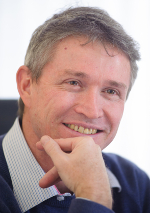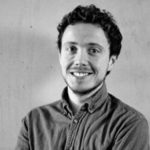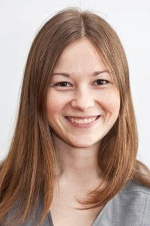Scientific Speakers

Tilmann Esslinger, ETHZ
Building quantum systems from scratch: supersolids and more
Cooling and manipulating atomic gases have opened up new avenues to explore fundamental concepts in quantum many-body physics. Synthetically created potentials and control of atom-atom interactions have made it possible to tailor the properties of experimental systems at a microscopic level. This led to the concept of quantum simulation – here a system capable of reproducing the physics of many-body Hamiltonians. One of the goals of this approach is to provide answers to open questions in the context of condensed matter physics. An equally important frontier is the construction of novel systems, such as supersolids, which may at present not be realizable in solid-state or other systems. This path leads to new questions and surprises.

Andrew Forbes (University of Witwatersrand and Johannesberg)
Manipulating Structured Light
Structured light is a term used to describe optical fields that have been tailored in their spatial intensity, phase and polarisation distributions, and may even be extended to include tailored light in the time and frequency domain too. Structured light has found many applications, including optical manipulation, atom optics, high-dimensional quantum information processing, laser materials processing, light-matter interactions, novel lasers and so on, spanning both fundamental science and applications. In this lecture series we will explore how to create, manipulate and detect structured light fields, and cover some example applications in classical and quantum optics. As part of the lecture series we will have a hands-on tutorial to produce some structured light fields using digital holograms.

Susanne Yelin (University of Connecticut, Harvard University)
Controlling light and matter using cooperative radiation
It is well known that spontaneous emission, typically assumed to be an independent process for
each atom, can be correlated due to the interference of light emitted by different atoms.
Cooperative radiation phenomena such as Dicke’s superradiance has been explored in systems
ranging from individual atoms to black holes.
Recently, such cooperative radiation emerged as a promising method for manipulating systems
ranging from unordered gases to ordered atomic arrays to two‐dimensional semiconductor
materials. I will discuss several theoretical ideas, ongoing experiments to implement them, as well as potential applications of such effects, including realization of topological optical systems,
quantum nonlinear optics, molecule cooling, and quantum information processing.

Peter Barker (University College London)
Levitated quantum optomechanics with nanoparticles
Levitated optomechanics has become an important platform for exploring the macroscopic limits of quantum mechanics. In this lecture I will describe why developing methods to cool and manipulate levitated nanoparticles will allow us to probe the classical-quantum boundary, wavefunction collapse mechanisms and possibly even quantum gravity. As part of this introduction, I will also discuss how these nanoscale oscillators, isolated by levitation in vacuum, can be used to measure short range forces and as highly sensitive resonant sensors.
I will then describe the methods that have been developed to cool and control the centre-of-mass motion of these systems. This includes cavity cooling, feedback cooling, and internal cooling of trapped particles using laser refrigeration. I will also discuss trap loading methods, and heating and particle stability in these systems. Finally, I will outline the prospects and challenges for future experiments.

Francesco Piazza (Max Planck Institute for the Physics of Complex Systems Dresden)
Quantum Nonlinear Optics
In this lecture series, I plan to introduce the students to the field of quantum nonlinear optics, presenting recent experimental and theoretical developments as well as challenges. I will discuss several scenarios and provide a few concrete examples of platforms involving strongly coupled light and matter. I would then discuss how the usual paradigm of quantum nonlinear optics can be modified if the matter carries intrinsic quantum correlations.
Young Scientist speakers

Monika Aidelsburger, LMU Munich and MPI Quantum Optics
Artificial gauge fields with ultracold atoms in optical lattices
Topological states of matter exhibit unique conductivity properties, which are extremely robust against perturbations and make them particularly interesting for applications. One of the most prominent examples is the integer quantum Hall effect, where a two-dimensional electron gas under extreme conditions exhibits a quantized Hall conductivity. Ultracold atoms in optical lattices provide access to these phenomena in a controlled laboratory environment. I will discuss how artificial gauge fields can be engineered for charge-neutral atoms, explain recent experiments on topological phenomena and present ongoing efforts towards the engineering of complete gauge theories, where the synthetic gauge field itself is dynamical.

Graham Bruce, University of St Andrews
Making the most of interference: the application of laser speckle and computer-generated holography to cold atoms, optical trapping and precision metrology.
In this talk, I will present a variety of types of structured light, how they can be generated, and what they can be used for. The development of new laser beam shaping methods is important in a variety of fields within optics, atomic physics and biophotonics. Spatial light modulators offer a highly versatile method of time-dependent beam shaping, based on imprinting a phase profile onto an incident laser beam that determines the intensity in the far-field. I will review our approaches to tailoring the light field, and show how this can be used for the manipulation of ultracold atoms and levitated microparticles, with experiments including the realisation of topologically-protected qubits and the fastest man-made spinning object.
Even the interference resulting from scattering of laser light by a random medium, which corrupts the beam profile into a grainy pattern known as speckle, can be made to be useful. The formation of speckle is commonly regarded as a randomization process which destroys information contained within the initial beam and is deleterious to many optical systems. Indeed, many engineers study speckle to remove its effect. Intriguingly however, the processes that produce the speckle are entirely linear, and there is growing recognition that this complex pattern is rich in useful information on both the incident laser source and the environment, with startling potential uses. I will demonstrate our recent results, which show that speckle can be used as a sensitive probe of wavelength changes of the light, and how this can be used to stabilize the wavelength of lasers in a compact system suitable for portable cold atom systems.

Alexandra Sheremet, Institut Langevin, ESPCI, Paris, France
Collective light-matter interface coupled to a nanophotonic waveguide
Light-matter interface is a fascinating research topic, which brings a connection between fundamental nature and practical applications. A promising approach for the realization of such interfaces is based on ensemble of neutral atoms both in free space and trapped near a nanoscale waveguide. Collective and cooperative effects manifested in an atomic ensemble could provide essential enhancement of the coupling strength between light and atomic subsystems. Moreover, the presence of an optical nanofiber strongly modifies the character of atomic interaction and results in long-range dipole-dipole coupling between atoms not only via the vacuum, but also through the waveguide mode. In this lecture we will study how a nanofibers allow to mediate and to control long-range interaction between atoms, and how this long-range atomic interaction can be used to study novel physical phenomena, such as chirality effects, subradiance and large Bragg reflection.
Career Speakers
Andreas Aumann, BMW (Vice President Product Management BMW i, eMobility)
From a PHD in AMO physics to a career in automotive management
I will provide an overview on my career path from AMO physics to management to raise awareness of potential opportunities, rewards and challenges.
- Personal introduction
- AMO Physics: Optical Patterns and Quasipatterns in Alkali Metal Vapor with Feedback
- Automotive Management: BMW i Product Management and eMobility
- Career choices: Tough decisions and no-brainers, leaps of faith and leaps of fate
- Flashlight: Expat in China
- Perspective: How to decide and how to prepare for a career in management?
- Retrospective: The PhD years. What would I do differently, today?
